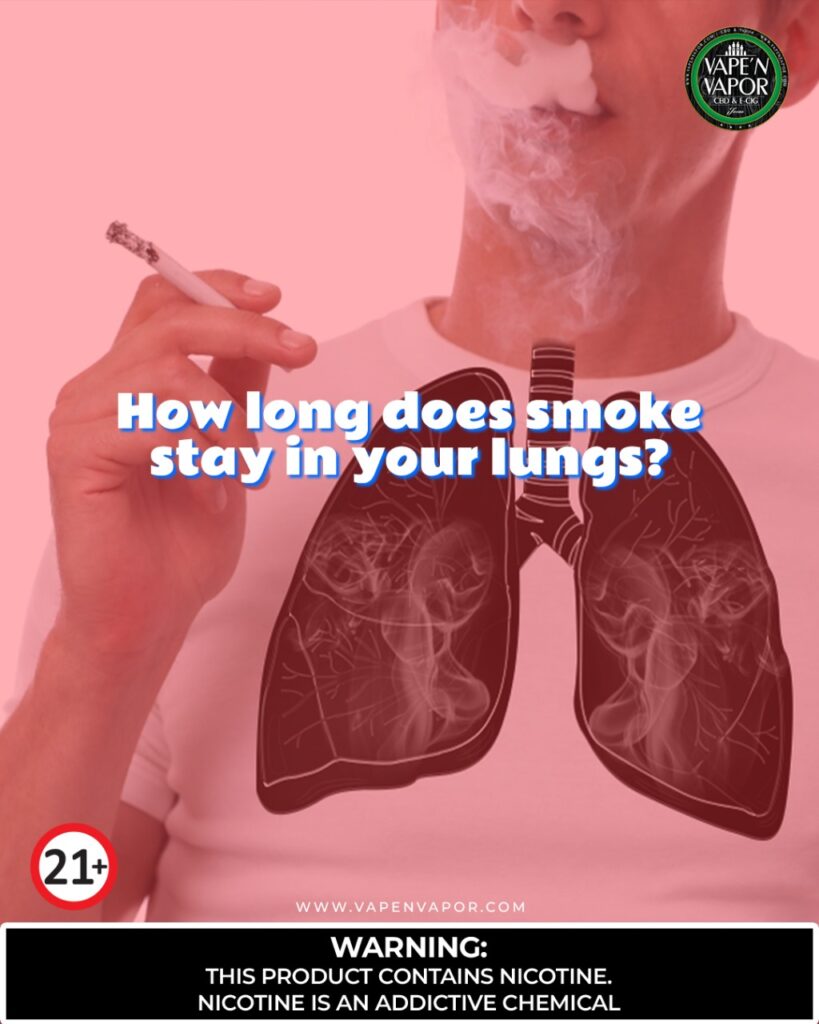No products in the cart.
How Long Does Smoke Stay In Your Lungs?

18
Apr
Smoking consumes nicotine as well as other toxins. Ever wonder how long the chemicals from smoking cigarettes, such as nicotine, stay in your body? And how long will it take you to get rid of them? If so, you’ve come to the right place!
Above all, it’s important to realize that our bodies can only repair themselves to a certain extent. This suggests that quitting smoking is the only step towards beginning the process of self-healing. First, let’s discuss nicotine. Nicotine is the component in cigarettes that leads to addiction. It has a two-hour half-life. Recall that the “half-life” of a substance is the amount of time it takes for half of that molecule to to be removed from your body.
Nicotine has a short half – life; it takes your body 3 to 5 days to get clear of nicotine entirely. This is the main reason why withdrawals are tough during the first 4 or 5 days. In 3 to 5 days, the nicotine in cigarettes will exit your lungs, but it can still be found in your intestines. This is because your body converts nicotine into cotinine, which is a chemical that is eliminated through urine.
It’s advisable to keep in mind that each individual is different and responds to these chemical toxins in different ways. A few of the variables are how long you’ve been exposed to these substances, how much of them you eat, how they interact with other substances in your body, and how healthy you are overall. Beyond only nicotine, cigarettes also contain almost 4,000 other substances. Let’s talk about these compounds and how long they stay in your lungs after you stop smoking.
Smoke in Your Lungs
When you breathe in smoke, whether vaping or cigarettes, your lungs are attacked by a multitude of dangerous chemicals. Tar, carbon monoxide, formaldehyde, cadmium, arsenic, benzene, and other carcinogens are among these substances. These harmful particles take up residence in the deepest corners of your lungs, disrupting their normal operation and causing inflammation. These poisons have the potential to cause respiratory conditions and raise the chance of developing chronic illnesses over time.
Gaseous exchange, which releases carbon dioxide and permits oxygen to enter the circulation, is carried out by the lungs. Smoke, on the other hand, upsets this delicate balance by damaging lung function and compromising your general health.
Notoriety for being a part of smoke, tar is especially sneaky. It sticks to the walls of the airways, preventing mucus from clearing and preventing airflow. This sticky residue increases the risk of infections by impeding respiratory function and providing a haven for germs to grow.
Another result of smoke, carbon monoxide, attaches itself to hemoglobin, the molecule that carries oxygen throughout the body, causing mayhem. This reduces the blood’s ability to transport oxygen, which exacerbates pre-existing respiratory disorders and causes tissue hypoxia.
One of the strongest carcinogens in smoking, formaldehyde, damages cells and encourages the formation of malignant growths in the lungs. Furthermore, smoking is the primary cause of lung cancer due to the abundance of toxins in smoke that significantly increase the chance of developing lung cancer.
The body is remarkably resilient, but it takes a long time to fully cleanse the lungs from the damage caused by smoking. Certain toxins can be eliminated by coughing and mucociliary clearance, while other toxins remain in the lung tissues and cause ongoing tissue damage and inflammation.
Quitting Smoking – ATimeline
To begin the process of quitting, you must have a lifelong aim. You are headed in the correct direction if you have chosen to embark on this trip. However, there are many psychological and physical obstacles on this road. Knowing how long it takes to stop smoking will help you prepare for what to anticipate along the journey.
Day 1 – 3: Your body is adjusting to the lack of nicotine, therefore this first stage is usually the most difficult. During this time, withdrawal symptoms may reach their zenith, ranging from irritability to strong cravings. The body cries out in protest, exhibiting symptoms similar to a mild case of the flu as soon as nicotine receptors in the brain are not triggered.
Day 4 – 7: The physical symptoms start to go away, but the threat of psychological desires could still be there. Withdrawal symptoms lessen when the body becomes used to not having nicotine. However, psychological triggers like social events or stress might cause strong cravings that will challenge your willpower to abstain from smoking.
Week 2 – 4: As lung function begins to return, breathing increasingly gets easier. Your energy levels rise, and you could even enjoy the revival of your previously numbed sensations of smell and taste. Your smoking-related chronic coughing starts to lessen, which opens your airways and improves your respiratory system.
Month 1 – 3: The risk of heart disease declines as lung function is improving. Though less intense, cravings might occasionally surface and catch you off guard when you’re most vulnerable. However, every day that goes by that you don’t use nicotine makes your body stronger and more capable of withstanding the intense cravings.
3 – 6 Months: This time frame represents important turning points in your path to stop smoking. Breathlessness and spells of coughing subside when your respiratory system is heavily repaired. The cilia, which are microscopic hair-like structures that line the airways, start to develop again and resume their role of removing debris and mucus from the lungs. Physical endurance rises with improved lung capacity, enabling you to partake in activities that were previously restricted by smoking.
6 months: Breathlessness and spells of coughing subside as your respiratory system is significantly repaired. When you quit smoking, your chance of having a heart attack drops to half that of a smoker, which gives you confidence that you’ve made progress in improving your cardiovascular health. Your immune system also recovers, strengthening your body’s resistance to diseases and infections.
1 year: Reaching this check point should be celebrated as it represents a major turning point in your path to improved health. Your chance of developing coronary heart disease is now comparable to that of a nonsmoker, which is a critical turning point for your cardiovascular health. You become stronger, healthier, and more resilient than ever before when the final traces of nicotine leave your body.
5 years: The five – year mark provides observable proof of the significant influence stopping smoking has on your long-term health. The stroke risk falls, providing comfort in the progress you’ve made to protect your health. Your body continues to heal and mend itself with every year that passes without smoking, undoing the harm that years of smoking have caused.
10 years: Reaching this milestone demonstrates your steadfast dedication to leading a smoke-free life. Relative to your smoking days, the risk of lung cancer is halved, providing concrete proof of the significant impact of stopping on your long-term health. Furthermore, the likelihood of other smoking-related malignancies, such those of the throat, mouth, and esophagus, is decreasing, which will strengthen your determination even more.
15 years: Reaching this milestone denotes the conclusion of your journey toward better health and your triumph over tobacco’s detrimental effects on your well-being. The fact that your risk of coronary heart disease is the same as that of a person who has never smoked indicates a clear break from your smoking past. As you experience the freedom and vitality that come with living a smoke-free life, you become an inspiration and a source of hope for those who are beginning the journey of quitting smoking.
So, does tar stay in my lungs forever?
In a nutshell, no. It might take your cilia one to nine months to mend after you stop smoking. But it can take much longer for the tar that initially caused all of this harm to exit your lungs. After 36 years of smoking, it takes the body 6 years to eliminate tar from the lungs.
Is vape juice safe?
Although vaping has grown in popularity as a supposedly safer alternative to smoking, concerns about the substances in vape juice have not gone away. Vape juice has its own set of risks; it often comprises propylene glycol, vegetable glycerin, flavorings, and varying amounts of nicotine. Inhaling flavorings, as well as propylene glycol and vegetable glycerin, might cause long-term respiratory irritation.
Final Thoughts
It is important to remember that, even if you do not smoke, your body has trace amounts of every chemical we have covered in this essay. This might result via ingestion of tainted food and drink, as well as inhaling them through the air. However, smoking-related elevated levels can result in a number of illnesses, including cancer.
There are almost 4,000 harmful compounds linked to cigarettes, each with unique risks. Positively, when you stop smoking, your body may eliminate some of these poisons and cure itself to some degree. Remember that smoking has an impact on those around us as well. Smoking has second – and third – hand effects that might have an impact on your children, grandparents, partners, friends, and even pets.
